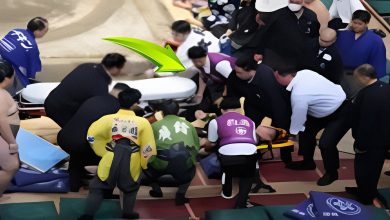Sergio Perez And Carlos Sainz Crash Video | Carlos and Sergio Crash Video | Carlos Sainz Crash

Jolyon Palmer, a former Formula 1 driver turned analyst, provided detailed insights into the crash between Carlos Sainz and Sergio Perez during the Azerbaijan Grand Prix. Palmer’s breakdown focused on the circumstances leading up to the incident, the decisions made by both drivers, and the consequences of their actions. His analysis offers a unique perspective on the crash, emphasizing the pressure, timing, and the technical challenges both drivers faced during this crucial moment.
The incident occurred as Sainz and Perez battled for position on the tight and challenging streets of Baku. With its mix of high-speed straights and narrow corners, the Azerbaijan Grand Prix circuit is notorious for causing collisions, particularly in situations where drivers are pushing to gain or maintain track position. Palmer highlighted that this context is crucial when analyzing the crash. Both drivers were operating in a high-pressure environment, with split-second decisions playing a pivotal role in the outcome.
Palmer began by examining Sergio Perez’s approach to the situation. Perez, known for his aggressive yet calculated driving style, was trying to hold his position. However, Palmer suggested that Perez may have been too optimistic in his defense against Sainz. As the two drivers entered a tight corner, Perez appeared to leave minimal space for Sainz, which made it almost impossible for Sainz to avoid contact. Palmer pointed out that while defending aggressively is part of the game in F1, Perez may have misjudged the risk factor in this particular instance, especially given the tight confines of the Baku circuit.
On the other hand, Carlos Sainz, driving for Ferrari, was attempting to pass Perez. According to Palmer, Sainz may have miscalculated the amount of space he had to make the maneuver. Sainz’s car clipped Perez’s, resulting in the crash. Palmer noted that while it’s easy to blame Sainz for the contact, it’s important to consider how difficult overtaking can be in such situations. The Baku circuit leaves little room for error, and Sainz’s ambition to take the position from Perez may have been a factor in the crash.
Palmer also discussed the timing of the incident. Both drivers were on the limit of their cars’ capabilities, trying to push their tires and brakes to the maximum. In Palmer’s view, this is where the incident became inevitable. The timing of the crash—mid-race when tire wear was becoming a factor—meant that both drivers had to be cautious about grip and braking zones. Palmer speculated that Sainz’s attempt to overtake Perez may have been slightly mistimed, as his tires were not in optimal condition, leading to a loss of grip when he needed it most.
One of the critical points in Palmer’s analysis was the role of communication between the drivers and their teams. Palmer noted that radio messages played a significant role in how both Sainz and Perez approached the situation. In modern F1, drivers are constantly updated by their engineers about tire conditions, rival strategies, and optimal racing lines. Palmer pointed out that in the lead-up to the crash, both drivers were likely receiving information from their teams that influenced their decision-making. For instance, if Sainz was being told that his tires were degrading or that Perez was struggling with his brakes, it may have encouraged him to make the move at that moment. Similarly, if Perez was warned about Sainz’s proximity, it could have influenced how tightly he defended his position. In Palmer’s view, these factors combined to create the perfect storm for the crash.
Another element Palmer examined was the aftermath of the crash. Both Sainz and Perez suffered damage to their cars, which impacted their race results. Palmer noted that the crash could have been avoided if either driver had shown more restraint. While racing incidents are common in F1, especially on circuits like Baku, Palmer believed that both drivers could have managed the situation differently. For Perez, perhaps a slightly less aggressive defense could have given him more breathing room, avoiding the contact. For Sainz, a more cautious approach to overtaking might have allowed him to pass Perez cleanly later in the race.
Palmer also touched on the broader implications of the crash for both drivers’ seasons. For Perez, who was in contention for valuable points in the championship, the incident represented a missed opportunity. Sainz, on the other hand, was driving for Ferrari, a team that has high expectations every season. Palmer suggested that such incidents could weigh heavily on both drivers, particularly in terms of how their teams view their decision-making in high-pressure scenarios. In F1, drivers are constantly being evaluated, and crashes like these can impact their reputation and future opportunities within their teams.
In conclusion, Jolyon Palmer’s analysis of the crash between Carlos Sainz and Sergio Perez at the Azerbaijan Grand Prix was a balanced and insightful examination of the incident. Palmer emphasized that both drivers were under immense pressure and that their split-second decisions led to the unfortunate outcome. While it’s easy to assign blame, Palmer’s analysis showed that the situation was far more complex, involving factors such as tire wear, team communication, and the challenging nature of the Baku circuit. Ultimately, Palmer believed that the crash was a racing incident, but one that could have been avoided with slightly more caution from both drivers.








